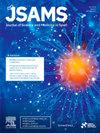Balance assessment with smartphone devices in para-footballers with cerebral palsy
IF 3
2区 医学
Q1 SPORT SCIENCES
引用次数: 0
Abstract
Objectives
To explore whether the mean lumbar acceleration is a feasible tool for determining minimum eligibility criteria to compete in cerebral palsy football, differentiating between new sports classes, and to assess the effect of foot contacts on balance evaluation and class distinction.
Design
Cross-sectional study.
Methods
A total of 146 male cerebral palsy footballers classified into FT1 (n=34), FT2 (n=87), and FT3 (n=25), alongside 12 non-impaired athletes as a control group, participated. Two trials of one-leg standing, performed with the more and less affected legs, were measured using a smartphone-based accelerometer.
Results
Reliability was moderate-to-excellent (ICC3,1 > 0.70; SEM < 20 %). Significant differences were observed between legs for footballers with cerebral palsy but not for the control group. Mean lumbar acceleration and the number of foot contacts showed significant differences between footballers with cerebral palsy and controls, with pairwise comparisons revealing distinctions between classes. Receiver operating characteristic curves demonstrated high sensitivity and specificity for distinguishing the control group from FT3 using the most affected leg (1.00 [excellent]), with a cutoff score of 0.115 m/s2 achieving very high sensitivity and specificity.
Conclusions
Mean lumbar acceleration appears to be a suitable metric for assessing minimum impairment criteria for eligibility in para-sports for ambulant athletes with cerebral palsy. However, foot contacts during one-leg standing tests may mask true balance performance in individuals with more severe impairments, which could affect class distinction.
用智能手机评估患有脑瘫的准足球运动员的平衡能力
目的 探讨平均腰椎加速度是否是确定脑瘫足球运动员最低参赛资格标准、区分新运动级别的可行工具,并评估脚部接触对平衡评估和级别区分的影响。方法 共有146名男性脑瘫足球运动员参加,分为FT1组(34人)、FT2组(87人)和FT3组(25人),另有12名非障碍运动员作为对照组。使用基于智能手机的加速度计测量了两条单腿站立的试验,分别用受影响较多和较少的腿进行。结果可靠性为中等至优秀(ICC3,1 > 0.70; SEM < 20 %)。在脑瘫足球运动员的双腿之间观察到显著差异,而在对照组中则没有。平均腰部加速度和脚部接触次数在脑瘫足球运动员和对照组之间存在显著差异,配对比较显示了不同等级之间的区别。接收器操作特征曲线显示,使用受影响最严重的腿区分对照组和 FT3 的灵敏度和特异性都很高(1.00[优秀]),而 0.115 m/s2 的临界值达到了非常高的灵敏度和特异性。然而,单脚站立测试中的足部接触可能会掩盖有较严重障碍的个体的真实平衡表现,从而影响等级区分。
本文章由计算机程序翻译,如有差异,请以英文原文为准。
求助全文
约1分钟内获得全文
求助全文
来源期刊
CiteScore
7.40
自引率
10.00%
发文量
198
审稿时长
48 days
期刊介绍:
The Journal of Science and Medicine in Sport is the official journal of Sports Medicine Australia (SMA) and is an an international refereed research publication covering all aspects of sport science and medicine.
The Journal considers for publication Original research and Review papers in the sub-disciplines relating generally to the broad sports medicine and sports science fields: sports medicine, sports injury (including injury epidemiology and injury prevention), physiotherapy, podiatry, physical activity and health, sports science, biomechanics, exercise physiology, motor control and learning, sport and exercise psychology, sports nutrition, public health (as relevant to sport and exercise), and rehabilitation and injury management. Manuscripts with an interdisciplinary perspective with specific applications to sport and exercise and its interaction with health will also be considered.

 求助内容:
求助内容: 应助结果提醒方式:
应助结果提醒方式:


